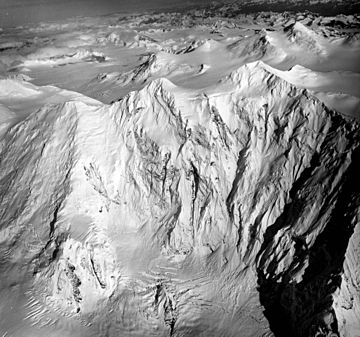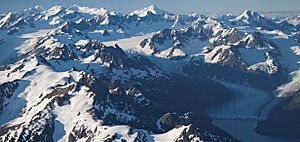Mount Witherspoon facts for kids
Quick facts for kids Mount Witherspoon |
|
|---|---|

Mt. Witherspoon right of center, from NW
(Mount Edison slightly left of center) |
|
| Highest point | |
| Elevation | 12,012 ft (3,661 m) |
| Prominence | 2,162 ft (659 m) |
| Isolation | 4.13 mi (6.65 km) |
| Parent peak | Mount Gilbert Lewis (12,250+ ft) |
| Listing | Highest major summits of the US 3000-meter summits of the US |
| Geography | |
| Location | Chugach National Forest Valdez-Cordova Borough Alaska, United States |
| Parent range | Chugach Mountains |
| Topo map | USGS Anchorage B-1 |
| Climbing | |
| First ascent | June 25, 1957 |
Mount Witherspoon is a very tall, icy mountain in Alaska, United States. It stands about 12,012 feet (3,661 meters) high. This mountain is located about 36 miles (58 km) northwest of Valdez. It is part of the Chugach Mountains and is found within the Chugach National Forest.
Mount Witherspoon is a remote peak, meaning it's far away from towns and cities. It is the fifth-highest mountain in the Chugach range. It is also the second-highest peak in the Dora Keen Range. This range is a 25-mile-long area that separates two large glaciers: the Harvard Glacier and the Yale Glacier. The heads of the Yale Glacier and Columbia Glacier are located between Mount Witherspoon and Mount Einstein.
The mountain was officially named in 1928 by the United States Board on Geographic Names. It was named to honor David C. Witherspoon. He was a topographer, a person who maps land, for the U.S. Geological Survey for 30 years. By the time he retired in 1921, David Witherspoon had mapped more of Alaska than any other person. The first ascent (the first time someone successfully climbed to the top) of Mount Witherspoon happened on June 25, 1957. The climbers were David Bohn, Arthur Maki, Jr., Martin Mushkin, and Lawrence E. Nielsen.
Weather and Climate
Mount Witherspoon is in a subarctic climate zone. This means it has long, cold, and snowy winters, but mild summers. The weather systems that come from the Gulf of Alaska hit the Chugach Mountains. This forces the air upwards, which causes a lot of rain and snow to fall. This process is called orographic lift.
Temperatures on the mountain can drop very low, sometimes below −20 °C (−4 °F). With the wind, it can feel even colder, below −30 °C (−22 °F). This cold and snowy climate helps to support the large glaciers around the mountain, like the Harvard, Yale, and Columbia Glaciers. The best time to visit or try to climb Mount Witherspoon is usually from May through June. This is when the weather is most favorable.



